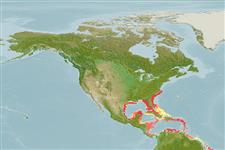>
Ophidiiformes (Cusk eels) >
Ophidiidae (Cusk-eels) > Ophidiinae
Etymology: Ophidion: Diminutive of Greek, ophis = serpent (Ref. 45335); antipholus: Named for the brothers Antipholus (Shakespeare's The Comedy of Errors), whose identities were confused throughout the play; noun in apposition..
More on authors: Lea & Robins.
Environment: milieu / climate zone / depth range / distribution range
Ecologie
marien benthopelagisch; diepte 10 - 69 m (Ref. 81834), usually 15 - 40 m (Ref. 81834). Subtropical
Western Atlantic. USA (from South Carolina to Palm Beach, Florida) and Mexico (off northern coast of Yucatan).
Grootte / Gewicht / Leeftijd
Maturity: Lm ? range ? - ? cm
Max length : 21.0 cm SL mannelijk / geslacht onbekend; (Ref. 81834)
Korte beschrijving
Determinatiesleutels | Morfologie | Morfometrie
Dorsale zachte stralen (totaal) : 111 - 133; Anale zachte stralen: 94 - 103; Wervels: 65 - 69. This species is characterized by the following features: D 111-133 (usually 116-123); A 94-103; pectoral fin rays 18 or 19 (rarely 20 or 21); precaudal vertebrae 15-17 (usually 16), caudal vertebrae 49-53 (usually 50-52), total vertebrae 65-69 (usually 66-68); lower arm of first gill arch with 5 or 6 developed rakers; rounded head profile with mouth distinctly inferior; dorsal and ventral profiles of body nearly parallel for much of its length; unmarked body; short and unequal pelvic-fin rays, longer reaching to point directly under anterior edge of opercle (Ref. 81834).
Observed on open sand and mud bottoms (Ref. 81834). Reproductive strategy possibly similar to other members of this family featuring oviparity, with oval pelagic eggs floating in a gelatinous mass (Ref. 205).
Levenscyclus en paargedrag
Maturities | Voortplanting | Spawnings | Egg(s) | Fecundities | Larven
Lea, R.N. and C.R. Robins, 2003. Four new species of the genus Ophidion (Pisces: Ophidiidae) from the western Atlantic Ocean. University of Kansas Museum of Natural History, Scientific Papers No. 31:1-9. (Ref. 81834)
Status op de Rode Lijst van het IUCN (Ref. 130435)
Gevaar voor de mens
Harmless
Gebruik door de mens
Tools
Speciale rapporten
Download XML
Internetbronnen
Estimates based on models
Preferred temperature (Ref.
123201): 22.9 - 27.7, mean 25.5 °C (based on 160 cells).
Fylogenetische diversiteitsindex (Ref.
82804): PD
50 = 0.5000 [Uniqueness, from 0.5 = low to 2.0 = high].
Bayesian length-weight: a=0.00102 (0.00046 - 0.00225), b=3.06 (2.88 - 3.24), in cm total length, based on all LWR estimates for this body shape (Ref.
93245).
Trofisch niveau (Ref.
69278): 3.6 ±0.7 se; based on size and trophs of closest relatives
Weerstandsvermogen (Ref.
120179): Hoog, minimale populatieverdubbelingstijd minder dan 15 maanden (Preliminary K or Fecundity.).
Fishing Vulnerability (Ref.
59153): Low vulnerability (16 of 100).
